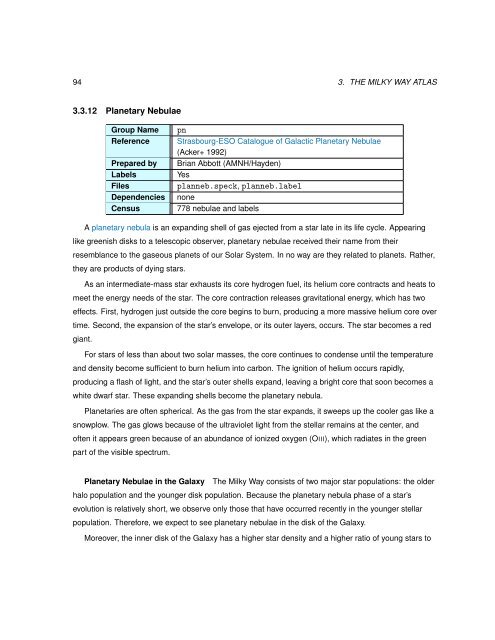Digital Universe Guide - Hayden Planetarium
Digital Universe Guide - Hayden Planetarium
Digital Universe Guide - Hayden Planetarium
You also want an ePaper? Increase the reach of your titles
YUMPU automatically turns print PDFs into web optimized ePapers that Google loves.
94 3. THE MILKY WAY ATLAS<br />
3.3.12 Planetary Nebulae<br />
Group Name pn<br />
Reference Strasbourg-ESO Catalogue of Galactic Planetary Nebulae<br />
(Acker+ 1992)<br />
Prepared by Brian Abbott (AMNH/<strong>Hayden</strong>)<br />
Labels Yes<br />
Files planneb.speck, planneb.label<br />
Dependencies none<br />
Census 778 nebulae and labels<br />
A planetary nebula is an expanding shell of gas ejected from a star late in its life cycle. Appearing<br />
like greenish disks to a telescopic observer, planetary nebulae received their name from their<br />
resemblance to the gaseous planets of our Solar System. In no way are they related to planets. Rather,<br />
they are products of dying stars.<br />
As an intermediate-mass star exhausts its core hydrogen fuel, its helium core contracts and heats to<br />
meet the energy needs of the star. The core contraction releases gravitational energy, which has two<br />
effects. First, hydrogen just outside the core begins to burn, producing a more massive helium core over<br />
time. Second, the expansion of the star’s envelope, or its outer layers, occurs. The star becomes a red<br />
giant.<br />
For stars of less than about two solar masses, the core continues to condense until the temperature<br />
and density become sufficient to burn helium into carbon. The ignition of helium occurs rapidly,<br />
producing a flash of light, and the star’s outer shells expand, leaving a bright core that soon becomes a<br />
white dwarf star. These expanding shells become the planetary nebula.<br />
Planetaries are often spherical. As the gas from the star expands, it sweeps up the cooler gas like a<br />
snowplow. The gas glows because of the ultraviolet light from the stellar remains at the center, and<br />
often it appears green because of an abundance of ionized oxygen (OIII), which radiates in the green<br />
part of the visible spectrum.<br />
Planetary Nebulae in the Galaxy The Milky Way consists of two major star populations: the older<br />
halo population and the younger disk population. Because the planetary nebula phase of a star’s<br />
evolution is relatively short, we observe only those that have occurred recently in the younger stellar<br />
population. Therefore, we expect to see planetary nebulae in the disk of the Galaxy.<br />
Moreover, the inner disk of the Galaxy has a higher star density and a higher ratio of young stars to





